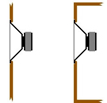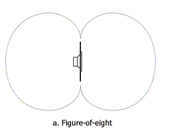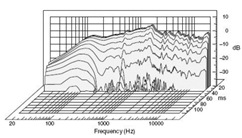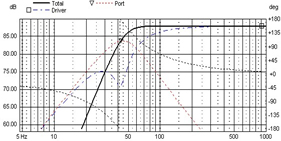Basic guide to speaker enclosures
The enclosure is instrumental in the functioning of any speaker. I started writing this blog to clarify the basic enclosures types and what they do, the good, the bad and the sometimes ugly, in a way that is accessible but also gives enough depth to base your decision on when starting your speaker project. Moreover, offer you a good understanding of the pros and cons of these designs. To keep things clear, a few variants and subjects like horn speakers have been omitted. These demand their own blogs in the future. This blog will mostly stay away from subjective observations of the different types of enclosures, although this might be difficult when talking HiFi. The following enclosures types and topics will be discussed.
- The need for an enclosure
- Finite "open" baffle
- Sealed box
- Vented/bass reflex enclosure
- Transmission line
The need for an enclosure
Why would you need one in the first place? When a loudspeaker driver converts an electrical signal into a mechanical pistonic action, it compresses air in front of the cone/diaphragm, creating a pressure ripple or wave known as condensation. At the same time, it causes the opposite effect on the other side of the cone/diaphragm resulting in a partial vacuum known as rarefaction. Furthermore, vice versa, when the cone travels the other way depending on the electrical signal, this action is called oscillation.
Newton's Third Law: "For every action, there is an equal and opposite reaction."
The easiest way to visualise this is to see the pressure wave as +1 and the back wave as -1. When you add these up, you end up with zero in sound terminology; they cancel each other out. (Note: This is a very basic explanation and does not take into account factors like directivity etc.). This is not a desirable effect. This effect will need to be mitigated like in an open baffle, controlled like in a bass reflex or acoustic labyrinth or absorbed like in a sealed enclosure to give a speaker a usable frequency range.
Finite "open" baffle speaker enclosure
The ideal situation for a speaker driver would be the Infinite baffle, where the front and back waves would never meet and would present an infinite beaming surface. This allows the speaker to behave without any negative effects an enclosure would have like diffraction, baffle step loss, cabinet resonances. Unfortunately, this is simply not a practical solution, so there was a compromise made: the finite or open baffle speaker,


This enclosure mitigates the cancellation effects and creates a figure 8 model response where the sound waves cancel each other on the baffle sides but still provide output at the front and the back. Depending on the baffle size, there is a frequency where the wavelength is so long that it does not "see" the baffle and still cancels out fully. This is called the cut-off frequency. To make this cut-off more gradual than -18 dB per octave, the driver can be mounted off-center.
Pros - For instance, a simple cabinet with a 1 square meter wooden board with a hole for a full range driver would do as the most basic speaker build that would probably give you decent sound. - No cabinet resonances! - Figure 8 directivity limits the interaction with sidewalls. - Easy to start with |
| Cons - Hard to master the propagations of the front and back waves that can cancel or amplify each other at different frequencies. - Not all drivers are suitable for this application. A Qts of 1 and above is recommended. - Very dependent on the placement of the speaker to function properly |
The sealed box speaker enclosure
This is a variant of the infinite baffle concept where the back wave is separated from the front wave by fully absorbing it in a sealed enclosure. However, it does not present an infinite beaming surface for the driver.

The air trapped within the sealed enclosure acts as a spring for the woofer, which benefits from returning to its original position. Depending on the volume of air in the cabinet, this effect can be more or less. This is good for the woofers' transient response or accuracy. However, its performance is dependent on using the right woofer. Thankfully Dr. Richard Small made a guideline for the right kind of woofer. This is called the EBP formula or "efficiency bandwidth product."

When the result is lower or equal to 50, the speaker is suitable for use in a sealed enclosure. This is by no means an iron rule; most modern drivers have a higher than 50 EBP because of the popularity of ported enclosure where a higher value is more suitable. An example of a suitable sealed enclosure driver would be the GRS 10PF-8 10" this speaker has an Fs of 43 Hz and a Qes of 1.66
![]()

"typical timed response of a sealed system"
Pros - Predictability because the back-wave of the speaker is fully absorbed within the cabinet. - Forgiving: a sealed box volume can vary slightly without negative effects - Accuracy by the spring action of the trapped air within the cabinet helps the driver return to its original position faster. |
|
Cons - Early roll-off of the bass frequencies because of a higher Fs point - High excursion at the drivers' resonance point(Fs) - Cabinet resonances, because the drivers' back-wave is fully enclosed, must be absorbed within the cabinet to prevent unwanted resonances. This can be achieved using sufficient acoustic damping material - The cabinet needs to be airtight for it to function correctly. There are, however, variants that use a controlled opening in the cabinet(aperiodic port). |
The reflex enclosure speaker enclosure

These enclosures use a tuned port or slot to produce extended bass response around the drivers' Fs point, which is one of the most common enclosures. This reflex cabinet is also known as ported/vented enclosure.
The basic working of a port is very interesting. The common misconception is that it "pumps" air to create more bass. In fact, the air inside the port has a certain mass that will resonate at the frequency it is tuned at, usually the driver Fs point. This air mass in the port acts as a driver itself and will start to generate output at this point. Also known as a Helmholtz resonator. This output, however, is very specific and only happens near the frequency it is tuned for. This resonance effect also dampens the drivers' cone movement at the tuned frequency to a point where it becomes nearly motionless. This can be visible thru its impedance response, which shows a distinctive double hump shape. While extending the bass response in most cases, it can also create a "boombox" effect at a higher tuning frequency accentuating the lower bass frequencies.
 |  | |
1.1: Typical bass reflex enclosure response this example is from the SEAS Bitfrost kit based on the SEAS Excel W18NX001 woofer. The black line is the total system output, the blue dotted line is the woofer's output, and the red dotted line shows the port output. |
|
1.2: This is a spectral decay plot showing the effects of a bass-reflex design. This also called "the time penalty" The resonances used to generate the bass extension does not dissipate immediately; this hinders the ability for a driver to start and stop instantly. This smears the drivers bass response in the time domain. |
Pro's - Bass extension at and just below the speakers' Fs point - Well understood because it is the go-to cabinet for most speaker designers. - Forgiving, the internal volume of the enclosure can vary a bit without negative effects - Reduced distortion at the drivers' Fs point by limiting its movement at that point. |
| Con's - The time penalty(1.2) - Internal reflections of mid frequencies can exit thru the port, adding unwanted noise. - Port turbulence/noise is caused by an undersized port - Offers no resistance to the woofer below its tuning frequency. This can lead to over-excursion at lower frequency. |
Transmission line enclosure
In most cases, this enclosure also referred to as an acoustic labyrinth, uses a damped quarter wavelength pipe to augment the bass response of a system. (Note that a common and practical definition of a transmission line is used in this blog.)

The theory behind it implies an infinite pipe to present the correct resistance to the driver at any frequency. Unfortunately, infinity is not a practical design criterium. There are also different implementations like a sealed quarter-length transmission line.
In this implementation, the back wave is guided thru the line. This delays it, and this delay shifts the phase to 90° degrees. The effect this has is that the back wave is back in phase with the front signal and adds to the output rather than subtracting from it. The length of the pipe is easily calculated with the following formula:
 | F = Tuning frequency, the drivers' Fs point is commonly used |
Whilst this is a basic calculation, the damping of the line also affects the speed of sound within the line. This could theoretically slow the speed of sound within the line to 50%, but more realistically, with a medium damped line, this effect is about 35%, effectively allowing the line to be shorter.
A transmission also has specific driver requirements because it is coupled to a mass of air that lowers its f3 and does not need a high compliance driver. It does, however, need a rigid cone to control this column of air without deforming at higher volumes; this would lead to distortion. An example of a driver which can be used with a transmission line is the SEAS Prestige L16RNX - H1488-04.
Pro's - Less bass/mid-range distortion because this implementation dampens most high, mid and upper bass frequencies inside the line, reducing reflections and resonances. - Impressive bass response when implemented correctly even at lower volumes - Lower cone excursions at tuning frequency leading to even less distortion. |
|
Con's - Difficult to tune because of the many variables involved. - Very unforgiving: the cabinet needs to match the driver exactly, or it can lead to very poor results. - Endless forum discussions - Many variants like a tapered, mass loaded closed-ended etc. ( this can be a pro; however, when starting out, this can be convoluting) |
Hopefully, this blog has given you a bit more insight into the different types of enclosures. Condensing the information about these enclosures was difficult balancing depth and accessibility is a delicate thing. This may lead to every enclosure getting a dedicated blog on designing and tuning one, including MATH! However, in the meantime, I would recommend using software like WinISD to design your sealed and ported speakers.
Bibliography
Alden, R. (2017). Speaker Building 201 (1ste ed.). Audio Amateur, Incorporated.
Newell, P., & Holland, K. (2018). Loudspeakers. Taylor & Francis.
Des
Posted on wednesday 5 july 2023 08:41
Interesting article, however I thought a golden rule was never to build a cabinet with the same dimensions as it may resonance at a specific frequency.
Show more

 Home audio
Home audio  Audio components
Audio components  Crossover components
Crossover components  Test & measurement
Test & measurement  DIY kits
DIY kits  Accessories
Accessories  New products
New products  Speakers
Speakers Amplifiers
Amplifiers DAC converters
DAC converters DSP modules
DSP modules Turntables
Turntables Streamers
Streamers Woofers
Woofers Tweeters
Tweeters Exciters
Exciters Bass shakers
Bass shakers Plate amplifiers
Plate amplifiers Amplifier modules
Amplifier modules Single board computers
Single board computers Assembled crossovers
Assembled crossovers Printed Circuit Boards (PCB)
Printed Circuit Boards (PCB) Capacitors
Capacitors Resistors
Resistors Coils
Coils Circuit Breakers
Circuit Breakers Crossover tools
Crossover tools Screw terminals
Screw terminals Acoustic measurements
Acoustic measurements Electric measurements
Electric measurements Sound level meters
Sound level meters DIY amplifier kits
DIY amplifier kits DIY component packs
DIY component packs DIY speaker kit
DIY speaker kit DIY subwoofer kits
DIY subwoofer kits DIY bluetooth speaker
DIY bluetooth speaker DIY electronics kits
DIY electronics kits Binding posts
Binding posts Cabinet Hardware
Cabinet Hardware Cables
Cables Connectors
Connectors Speaker cabinets
Speaker cabinets Electromechanics
Electromechanics Power supplies
Power supplies Speaker repair
Speaker repair Workshop & tools
Workshop & tools Amplifier accessories
Amplifier accessories Stands & mounts
Stands & mounts Gift voucher
Gift voucher Books
Books New products
New products









 Speakers
Speakers Amplifiers
Amplifiers DAC converters
DAC converters DSP modules
DSP modules Turntables
Turntables Streamers
Streamers Woofers
Woofers Tweeters
Tweeters Exciters
Exciters Bass shakers
Bass shakers Plate amplifiers
Plate amplifiers Amplifier modules
Amplifier modules Single board computers
Single board computers Assembled crossovers
Assembled crossovers Printed Circuit Boards (PCB)
Printed Circuit Boards (PCB) Capacitors
Capacitors Resistors
Resistors Coils
Coils Circuit Breakers
Circuit Breakers Crossover tools
Crossover tools Screw terminals
Screw terminals Acoustic measurements
Acoustic measurements Electric measurements
Electric measurements Sound level meters
Sound level meters DIY amplifier kits
DIY amplifier kits DIY component packs
DIY component packs DIY speaker kit
DIY speaker kit DIY subwoofer kits
DIY subwoofer kits DIY bluetooth speaker
DIY bluetooth speaker DIY electronics kits
DIY electronics kits Binding posts
Binding posts Cabinet Hardware
Cabinet Hardware Cables
Cables Connectors
Connectors Speaker cabinets
Speaker cabinets Electromechanics
Electromechanics Power supplies
Power supplies Speaker repair
Speaker repair Workshop & tools
Workshop & tools Amplifier accessories
Amplifier accessories Stands & mounts
Stands & mounts Gift voucher
Gift voucher Books
Books New products
New products





